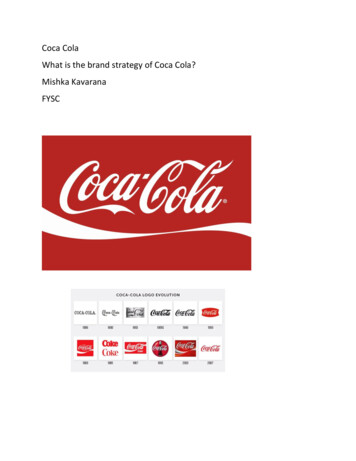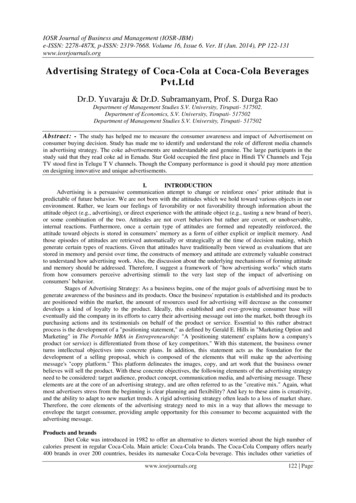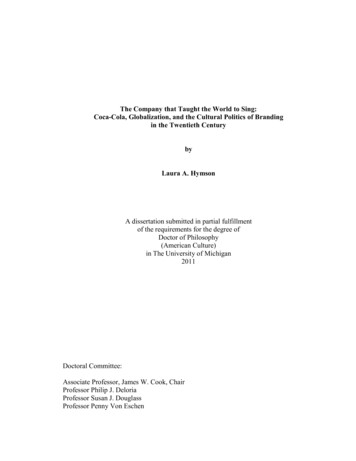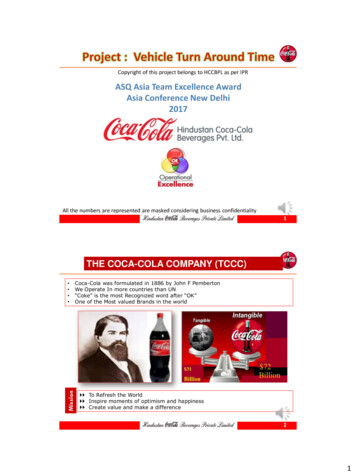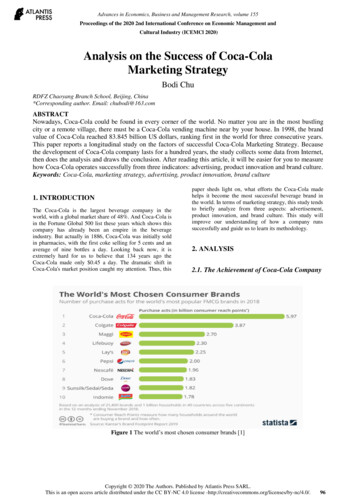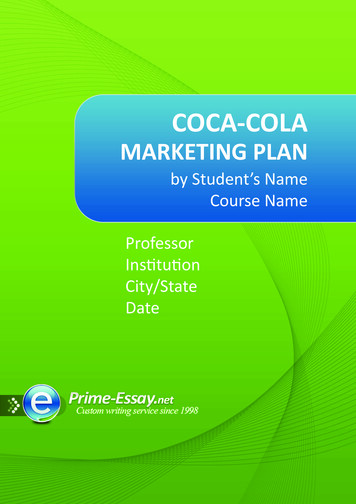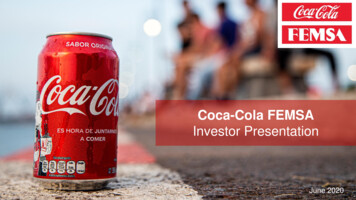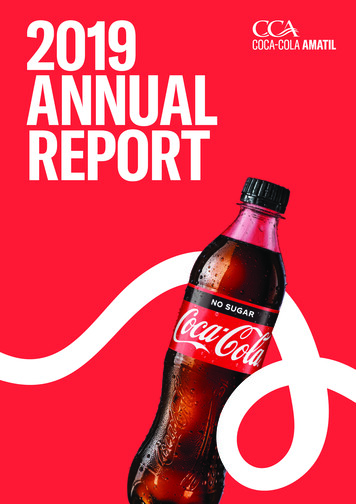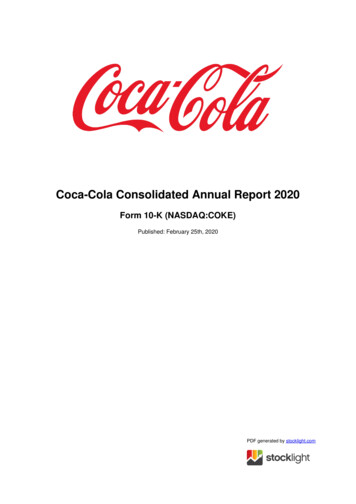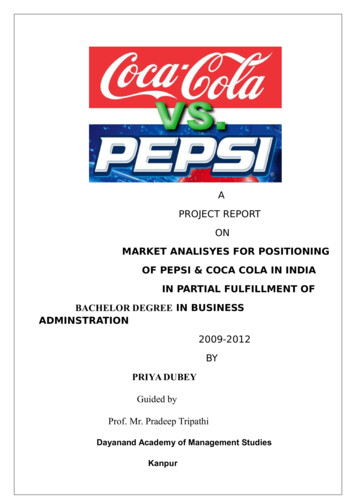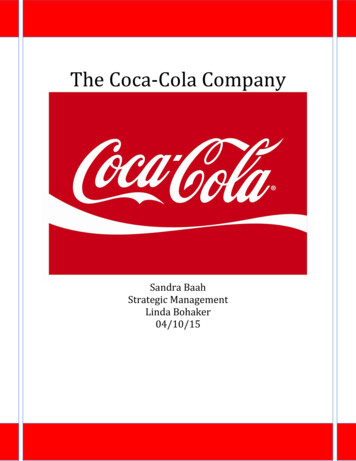
Transcription
The Coca-Cola CompanySandra BaahStrategic ManagementLinda Bohaker04/10/15
Table of ContentsAcknowledgment 2Introduction 3Mission 3- 4External Analysis 4Remote . 4-5Industry Analysis . 6Porters Five Forces .6-8Internal Analysis 8-11SWOT 8-11Long Term Objectives .11Generic Strategy .11-12Grand Strategy .13-14Functional Tactics .15Organizational Structure .16Leadership .16Culture .16-17Conclusion 17-18Work Cited 19-201
Acknowledgements:I would like to thank my dearest friends Kirsten Wright and Dina Ogilvie for staying up with me duringthose long nights and countless hours I spent on my capstone. Their constant support andentertainment helped me through this exciting process.Next, I would like to thank the business department for all their help. During my time at PrincipiaCollege, I have learned a lot from the business classes I have taken. It is through classes like Marketing,management and strategic Management that I am able to write this capstone paper. I have growntremendously as a student since I first arrived at Principia College; I attribute this growth to both theCollege and Business Department. Thank you for all your support and guidance.Last but not least I would like to thank my family for their support. Without their financial support andconstant encouragement I would not be where I am today.Thank you to all those who helped me throughout the entire time I spent on this paper directly orindirectly. You are much appreciated.2
IntroductionCoca Cola was first created in 1886 by a man named John S. Pemberton. (coca-cola.com) CocaCola is one of the world’s leading non-alcoholic soft drink manufacturers. Its products can befound in over 200 countries around the world. Its product portfolio consists of roughly more than400 brands; this includes soft drinks, energy drinks, and bottled water and as well as juiceproducts. The company is most well-known for its soft drink, coke. Since its existence, CocaCola has used extensive and diverse advertisements to increase its market share, this has led it tobecome one of the most recognized name brands in the world. The Coca-Cola brand is globallyvalued and recognized.In 2013 Coca-Cola had a total market share of 42.2% in the non-alcoholic beverage industry.Over the past decade, Coca-Cola has been experiencing a decline in sales due to increasinghealth and obesity concerns. Because of this, Coca-Cola has come up with long term objectives.One of its main objectives is to “double its revenue by 2020 and to acquire or develop scalable,innovative premium brands” (coca-cola.com). During the past few years Coca-Cola’s revenuehave been on the decline, “in 2014 Coca-Cola had a 15.4% of net income of revenue comparedto the previous year where it was 18.3%” (euromonitor.com). The decline in numbers does notmean Coca-Cola is not doing well; these figures are a result of the downfall of the carbonatedbeverage industry as whole. Coca-Cola is dealing with this issue by acquiring and branching outto healthier drink options such as Vitamin Water.Mission Statement“To refresh the world. To inspire moments of optimism and happiness.To create value andmake a difference."Vision People: Be a great place to work where people are inspired to be the best they can be.Portfolio: Bring to the world a portfolio of quality beverage brands that anticipate andsatisfy people's desires and needs.Partners: Nurture a winning network of customers and suppliers, together we createmutual, enduring value.Planet: Be a responsible citizen that makes a difference by helping build and supportsustainable communities.Profit: Maximize long-term return to shareowners while being mindful of our overallresponsibilities.Productivity: Be a highly effective, lean and fast-moving organization.Coca-Cola’s mission and vision work in cohesion, they both support each other. Both missionand vision addresses customer market; “to inspire moments of optimism and happiness and in its3
vision it’s to; bring the world a portfolio of quality beverage brands that anticipate and satisfypeoples desires and need” (coca-cola.com). Its key points in its mission and vision is how it plansto stay in business. It assures its shareholders it will “create value and make a difference as wellas maximize long term return to shareholders while being mindful of its overall responsibilities.”(coca-cola.com) Regarding productivity it plans on being a highly effective, lean and fastmoving organization.At first glance, Coca-Cola’s mission is broad and generic. It does not address all of itsstakeholders. Instead, its vision addresses all stakeholder groups. Both its mission and visioncommunicate its strategy. Together it shows what they want to do and how they are going to doit. Its strategy is to be globally known and its mission and vision suggests it’s going to do that bybeing socially responsible, providing a diverse product portfolio; providing several options for itsconsumers therefore gaining more market share, creating a good network between consumersand suppliers, maximizing profits and creating value for. (coca-cola.com)Coca-Cola’s mission and vision are consistent with trends in the external environments. Itsvision addresses what they need to in order to succeed in the future. In order to succeed, CocaCola has to examine the external environment and find the most appropriate strategies to survivein the economy.External AnalysisRemote EnvironmentCoca-Cola has several remote environment factors that affect the company. In the beverageindustry, Coca-Cola is affected by social, political, ecological and technological environmentalfactors. Remote environmental factors allows companies to make appropriate strategies based onoutside factors. According to Pearce and Robinson the authors of Strategic Management,Planning for Domestic and Global Competition “the environment presents firms withopportunities, threats, and constraints” (Pearce and Robinson, 90)SocialConsumers are becoming more health conscious, with the need of wanting to stay in shape andliving a healthier lifestyle. More than ever before, consumers want to know what they areconsuming. This remote factor has caused the beverage industry to come up with healthieralternatives. Companies are forced to use healthier ingredients in their beverages. An influx ofbaby boomers and generation X and Y are becoming more active. This social trend is causingcompanies in the beverage industry to make more fruit and vegetable based beverages. Theyhave to succumb to the needs of the consumers. According to the Wall Street article written byMarisa Taylor “with about 10.5 million people ages 55 and older now being health clubmembers—more than four times as many as in 1990—more companies are rolling out fitnessproducts aimed at the silver-haired set” (Taylor). With a population that high, this fitness trend4
creates an opportunity for companies such as Coca-Cola to create beverages that will attract thatmarket, therefore increasing its total market share. (Wording)EconomicEvery business in every industry is affected by economic factors. A growth or loss in theeconomy affects the industry either negatively or positively. According to The World Bank,“Overall, global growth is expected to rise moderately, to 3.0 percent in 2015, and average about3.3 percent through 2017. High-income countries are likely to see growth of 2.2 percent in 201517, up from 1.8 percent in 2014” (The World Bank). This expected forecast creates a path for anincrease in beverage sales because with more income coming in people are more likely toindulge in their guilty pleasures. In the U.S, disposable income is said to increase, according toIbis world, “disposable income is said to increase by 2.5% from 2014 to 2019”. (IBISWorld)This estimated increase in disposable income will allow people to spend more, which in turn willbenefit the industry as a whole.Other economic factors such as inflation, recession and unemployment rate can impact theeconomy negatively or positively depending on how low or high the numbers are. According tothe world bank, “the world inflation rate has gone down to 2.6 in 2013 down from 3.6 in 2012,and world unemployment rate was 6 in 2013.” (The World Bank)These factors such as highunemployment rate reduce the overall performance of the beverage industry; companies do notmake enough sales which therefore leads to a fall in profit margin. With both inflation andunemployment rates decreasing, the current state of the economy provides a positive state forCoca-Cola to articulate its strategy.TechnologyTechnology is a major factor. It has the ability to improve the performance and profitability of acompany. Companies in this industry are able to integrate technology into their productionsystem. Companies in the beverage industry are able to use several technological advances suchas CRM that allows companies to communicate with their consumers in order to predict andrespond to their needs.Ecological EnvironmentConsumers are looking for companies that are seriously involved in sustainable practices. Thesustainability trend has proven to be an important factor. There are consumers that vow to onlypurchase from companies that are “green”. This trend has forced companies to integratesustainable practices in their everyday operations. Although this trend of sustainability is widelyinfluenced by government regulations, companies are taking the initiative to launch techniquesthat help them reduce emission of toxic waste into the environment.5
Industry AnalysisThe beverage industry analysis gives a synopsis of the trends in the industry that Coca-Cola is apart of. Factors such as competitors, market size, and trends in the industry affect Coca-Cola andits strategic decision making. Globally, Coca-Cola is more dominant and has a majority of theglobal market share. Coca-Cola is the top company in the industry, according to Euromonitor“There was no significant change in the ranking of the global top 10 companies in the soft drinksmarket in 2012, with TCCC maintaining its top spot and continuing to keep a large gap betweenitself and the second player PepsiCo” (Euromonitor.com)The beverage industry is fairly large with several competitors. According to the beverageindustry survey, “The market share of the nonalcoholic beverage industry is highly concentrated.Carbonated soft drinks, for example, reflect approximately 88% of US retail sales, and arerepresented by the beverage brands of three companies: Coca-Cola, PepsiCo, and Dr PepperSnapple Group Inc.” (Agnese, 15). The industry comprises of sub-industries such as carbonateddrinks industry, alcoholic beverage, tea and coffee and as well as fruit and vegetable drinks. Themain competitors in the non-alcoholic beverage industry are Coca Cola, PepsiCo, and Dr PepperSnapple Group. In the carbonated soft drink industry, Coca-Cola has a total market share of36.1% while PepsiCo and Dr Pepper Snapple have a market share of 32.7% and 20.8%respectively.According to Standard and Poor’s they expect “sub-industry (Carbonated Drinks) to perform inline with the broader market over the next 12 months, reflecting steady volume trends ascompanies increase marketing spending behind core brands, as well as new productintroductions. We see improved trends for non-carbonated beverages as consumers return tohealthier products after briefly trading down to cheaper alternatives during the recession.”(Standard and Poor’s) Increased competition and extensive advertising is causing an upward risein the industry. Although there is a fall in the overall sales of carbonated drinks, the soft drinkindustry is doing well due to social factors such as consumer preference. According to Standardand Poor’s, flavored carbonated beverages appeal to young ethnic groups. (Standard and Poor’s)Although the beverage industry is steadily growing in terms of size, economic and geographictrends such as growth rate and market size affect the profitability of companies in this industry.Economic factors such as weakening foreign currency are affecting the industries negatively; lowcurrency rates compared to the US dollar is causing a decrease in profits for the industry. Thiscreates a barrier for profits for international sales.Porters Five ForcesPorter’s five forces is an analysis of five competitive forces that drives and compares howcompetitive an industry is. It was started by an economist named Michael Porter. He mentionsthat there are five forces that affect profitability in an industry; supplier power, threat of newentrants, threat of substitutes and power of customers. After evaluating these five forces6
companies can then use the results to determine ways to respond to those forces in order toremain or be profitable. These forces impact Coca-Cola and affect its decisions based on theindustry and as well as competitors.Threat of EntrantsThe threats of entry for the beverage industry are low, for example, entering the industry requireshigh fixed costs, immense labor and extensive marketing. New entrants have limited to no accessto distribution channels such as stores. Due to the fact that there are limited bottling companies’new entrants to the industry will have to build their own plants. Since there are alre
10.04.2015 · Coca-Cola to articulate its strategy. Technology Technology is a major factor. It has the ability to improve the performance and profitability of a company. Companies in this industry are able to integrate technology into their production system. Companies in the beverage industry are able to use several technological advances such as CRM that allows companies to communicate with their .
